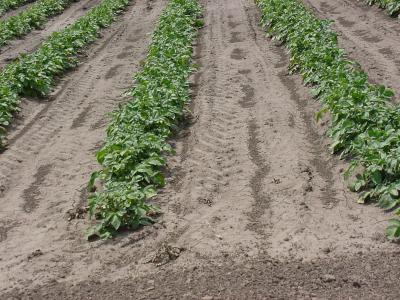
Potato require well-drained sandy loam soils with pH of 5-5.5.Potato scab disease is a problem in alkaline soils. Till the soil 8-12 inches deep. If a cover crop was planted on the site the previous fall, till it under inearly spring. Level the ground, wait for at least one week after tilling the cover crop before planting potato seeds. It is very important to test the soil in order to determine how much fertilizer to apply. Generally potato require about 0.4 pounds of nitrogen per 100 square feet which translates to about 2-3 pounds of 10-10-10 fertilizer per 100 square feet. Fertilizer is applied in a band 6-7 inches deep, and 2-3 inches to the side potato will lie on a bed. Do not put fertilizer in direct contact with the seed. The recommended fertilizer rates may be applied once or by split-application where half the rate is applied at planting and the other half applied when plants are4-6 inches tall.Some home gardeners prefer to use manure so they need to apply manure the previous year but make sure the manure is aged to prevent introduction of disease pathogens and weeds.
Mulch is usually beneficial in growing potatoes. After the potato plants have emerged, organic mulch can be applied to conserve moisture, help keep down weeds and cool the soil. Some gardeners cover rows of early potatoes with clear plastic film at planting to warm the soil and promote early growth when the soil temperature is low. When the plants emerge, remove the film to allow the plants to grow unrestricted. Irrigate to assure uniform moisture while the tubers are developing. A uniform moisture supply also helps to cool the ground and eliminate knobs caused by secondary growth. Maximum water use occur during vine growth and early tuber development. Reduce watering when vines begin to die in order to prevent tubers from rot organisms.
Potato cultivars are grouped by days to maturity, tuber color, tuber shape, and use
Classification based on maturity date is as follows:
Early maturing (70-85 days after emergence):
Dark Red Norland – Round red tuber with bright red skin, medium yielding and has some resistance to scab. Can be used boiling, roasting, and salad.
Norgold Russet – Oblong tuber with medium russet skin, medium yielding, and sometimes may have hollow heart. It is very good for baking.
Russet Norkotah – Long tuber with golden russet skin, medium yielding, and is very good baking.
Yukon Gold – Oblong tuber with yellow flesh, high yielding and suitable for many culinary uses such as baking, mashing, and roasting.
Medium maturing (85-100 days after emergence):
All Blue – Long tuber with dark blue-purple skin, and flesh. High yielding, and can be used for making salad, baking, and can be microwaved.
All Red – Oblong tuber with light red skin and flesh. Medium yielding and cane be microwaved, salad, and baking.
Katahdin -
Kennebec – Oblong tuber with white skin, and high yielding. Have deep eyes that sometimes make peeling difficult, and may become very large. It is suitable for chipping.
Sangre – Round tuber with dark red skin, and high yielding. Can be boiled, baked or used as salad. Stores very well and has excellent cooking quality. Sometimes form slight nets in some soils.
Yellow Finn – Oblong tuber with white skin and yellow flesh. Can be grown under different climatic conditions. Can be used as salad.
Late maturing (over 100 days after emergence):
Chipeta – Round/oblong tuber with white skin and creamy flesh. High yielding and good for chipping and baking. Requires low fertility and water.
Pontiac – Red skinned, high yielding, and fair cooking quality. Sometimes have misshapen tubers.
Red LaSoda – Oval shape with light red skin. High yielding, wide adaptability, deep eyes may make peeling difficult. Sometimes have cracks and hollow heart. Can be boiled, baked, and used as salad.
Russet Burbank – Long tuber type with medium russet skin. Medium to high yielding, and stores well. Can be used for baking and French fries. May have misshapen tubers, and very susceptible to stress induced diseases.
Russet Nugget – Oblong/long tuber with heavy russet skin. Medium yielding, and can be baked and for French fries. Resistant to many diseases and require low fertility and water.
Superior – White skinned variety.
Environmental Damage
Fungal Disease
Insect Damage
Additional pests and problems that may affect this plant:
Diseases
Harvesting and storage – Dig potatoes 2-3 weeks after the vines have naturally died. This lets the skin to harden thereby reducing bruising, peeling, and rot in storage. After harvesting, cure tubers in a dark place at 60-65 degrees F and relative humidity of 85% or higher for 10 days. After the tubers are cured keep them in a cool dark place with temperatures 40-45 degrees F with high humidity for 2-3 months.